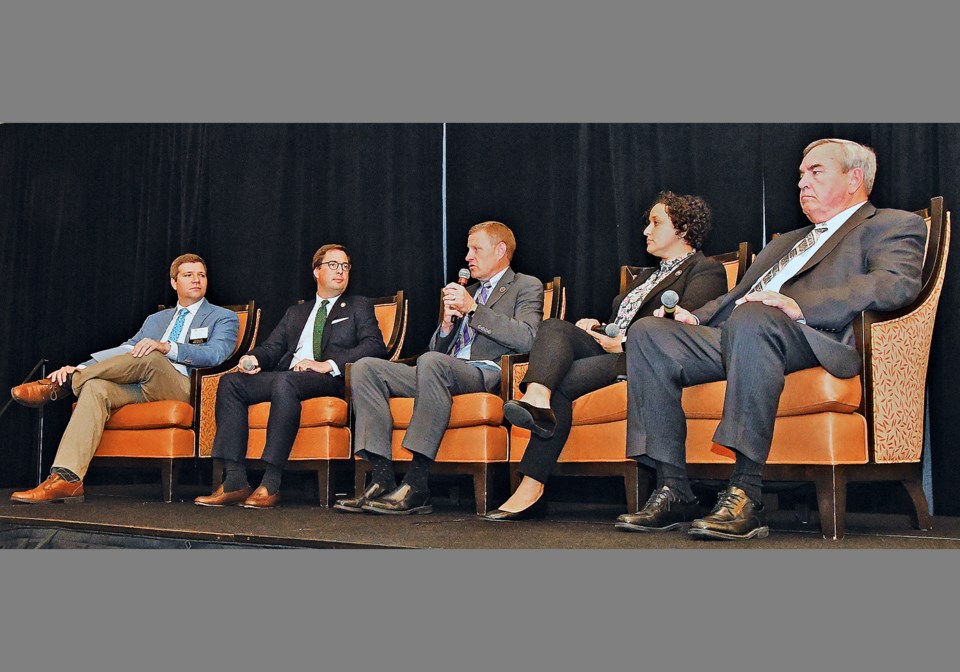Northern Virginia’s transportation network is benefiting from significant investments and almost has recovered from the pandemic, but challenges remain – most prominently, bridging Metrorail’s funding gap, regional leaders said Sept. 29 at the Northern Virginia Transportation Alliance’s (NVTA) 19th annual “What You Need to Know About Transportation” forum.
Virginia’s Amtrak ridership stands at 136 percent compared with 2019, commercial enplanements are at 99 percent and traffic volumes at 98 percent, said Virginia Deputy Secretary of Transportation Michael Sargent at the event, held at the Fairview Park Marriott in the Falls Church area.
Statewide transit ridership – excluding Virginia Railway Express (VRE) and Metrorail – is at 81 percent of 2019 levels, which is above the national average of 75 percent, Sargent said. But Metrorail’s ridership is 62 percent of pre-pandemic levels and VRE’s is 33 percent, he said.
State leaders are focusing on multiple key projects, including expanding the Express Lanes network, building a new Long Bridge in Arlington, making improvements along Interstate 81, optimizing transportation investments and refining the state’s SMART SCALE evaluation system for transportation projects, he said.
Sargent highlighted the funding gap for the Washington Metropolitan Area Transit Authority’s Metrorail system and said the transit agency’s woes cannot merely be attributed to the pandemic.
The system’s ridership declined nearly 20 percent from 2010 to 2019, while Virginia’s subsidies more than doubled during that period, Sargent said. “More money, fewer riders,” he summed up.
Metrorail is the country’s most expensive legacy heavy-rail system to operate and spends more on administration – and less on operations and maintenance – than comparable transit systems, Sargent said.
Metrorail must examine its costs, rebuild ridership, ensure safety, scrutinize labor expenses and workforce size and consider using more automation, which is common in world-class transit systems operated in Asia, he said.
“This is an inflection point for the system,” Sargent said. “There is no more money for business as usual. We’ve got to have tough conversations and that starts with looking at costs, first and foremost.”
Fairfax County Board of Supervisors Chairman Jeff McKay (D) said Metrorail generates $1.5 billion worth of revenue for Virginia each year. The transit system “is an investment not just in Northern Virginia, but an investment in the entire commonwealth of Virginia,” he said.
McKay said he hoped regional leaders would craft a solution for Metrorail’s woes that is both fair and permanent.
Metrorail’s difficulties require a balanced approach, said Jack Potter, president and CEO of the Metropolitan Washington Airports Authority.
“It’s everybody’s problem,” Potter said. “It has to be everybody’s challenge to fix it. [Metrorail’s] employees are part of the solution. They need to be invested in it.”
Washington Dulles International Airport and Ronald Reagan Washington National Airport are well-served by “thriving” Metrorail stations on their property, Potter said. Those stations allow passengers and employees from around the metropolitan area to access the airports, he said.
MWAA’s passenger total this year will be higher than 2019’s, indicating that matters are “moving in the right direction,” Potter said. The Airports Authority is committed to “driving costs down, making our airports a great place for airlines to serve this area, but also be profitable.”
Several major roadways cross MWAA’s property, and the organization wants to be a good neighbor, Potter said.
But Airports Authority officials are “extremely nervous” about planned work along Route 1 near National Airport that may pose a challenge to people trying to enter and leave the facility, Potter said. And the impact of all those new employees coming to work for Amazon in Crystal City only is beginning to emerge, he said.
McKay expounded on the efforts of the Northern Virginia Transportation Authority, on which he serves, which since being established in 2013 has financed $4.1 billion worth of transportation improvements. Those projects have generated nearly 42,000 jobs in the region, he added.
The expended moneys consisted of $3.1 billion for regional transportation projects (including $258 million for Metrorail-related initiatives) and $1 billion for smaller local projects, McKay said.
“Most of our constituents couldn’t care less whether a project is in Fairfax, Arlington, Falls Church, Loudoun, Prince William,” he said. “If they’re affected by it, they’re not thinking ‘What county am I in’ at the time. They’re thinking, ‘Why can’t we get our regional infrastructure to work together?’”
McKay was enthused about a bus-rapid-transit (BRT) project along the Richmond Highway corridor, which he said would improve not only that area’s transportation mobility but also its economic fortunes.
Supervisor Dalia Palchik (D-Providence), who chairs the Northern Virginia Transportation Commission (NVTC), said the group’s associated transit agencies serve 1.4 million riders each week and feature 7,619 stops on 249 routes. Overall, transit ridership is only 77 percent of what it was pre-pandemic, she said.
Palchik especially was excited about planning for a BRT route along Route 7 between Tysons and the Mark Center area of Alexandria.
In a panel discussion moderated by NVTA president Jason Stanford, the speakers said the pandemic altered – in some cases, permanently – the public’s transportation habits. More people are working from home and this likely will remain the case, they said. But single-occupant vehicle trips also have gone up following the pandemic.
“We need to meet people where they are and have multi-modal solutions,” McKay said.



